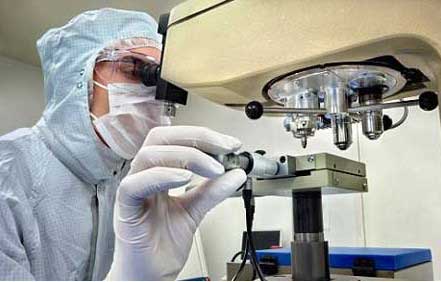當(dāng)前位置: Language Tips> 雙語新聞
分享到
 |
|
A British man may have fathered 600 children by repeatedly using his own sperm in a fertility clinic he ran, it has emerged. |
|
A British man may have fathered 600 children by repeatedly using his own sperm in a fertility clinic he ran, it has emerged. Bertold Wiesner and his wife Mary Barton founded a fertility clinic in London in the 1940s and helped women conceive 1,500 babies. It was thought that the clinic used a small number of highly intelligent friends as sperm donors but it has now emerged that around 600 of the babies were conceived using sperm from Mr Wiesner himself. Two men conceived at the clinic, Barry Stevens a film-maker from Canada and David Gollancz, a barrister in London, have researched the centre and DNA tests suggest Mr Wiesner, an Austrian biologist, provided two thirds of the donated sperm. Such a practice is outlawed now but at the time it was not known that Mr Wiesner was providing the majority of the samples. The same sperm donor should not be used to create so many children because of the risk that two of the offpsring will unwittingly meet and start a family of their own, which could cause serious genetic problems in their children. DNA tests were conducted on 18 people conceived at the clinic between 1943 and 1962. The results showed that two thirds of them were fathered by Mr Wiesner. Extrapolating this to the rest of the children conceived at the clinic it would suggest around 600 of the children were Mr Wiesner’s. Mr Gollancz told the Sunday Times: “A conservative estimate is that he would have been making 20 donations a year. “Using standard figures for the number of live births which result, including allowances for twins and miscarriages, I estimate that he is responsible for between 300 and 600 children.” In 1990 the Human Fertilisation and Embryology Act set up a regulator of fertility clinics and limits were set on the number of families a sperm or egg donor could provide. Sperm donors can provide samples for the creation of up to ten families. Around 2,000 children are born every year in Britain using donated eggs, sperm or embryos. Information about the donor is kept so the children can apply to find out the identity of their biological father and any half brothers or sisters once they turn 18. (Read by Nelly Min. Nelly Min is a journalist at the China Daily Website.) (Agencies) |
據(jù)報(bào)道,英國人威斯納在自己開辦的生育診所中屢次使用自己的精子,他的后代數(shù)量可能達(dá)600人之多。 伯托爾德?威斯納與妻子瑪麗?巴頓20世紀(jì)40年代在倫敦開設(shè)了一家生育診所,幫助前來就診的女性孕育了1500名后代。 當(dāng)時(shí)人們以為,有少量高智商的夫婦倆人的朋友為該診所捐精,但現(xiàn)在得知,大約600名后代都是使用威斯納自己的精子繁育的。 加拿大電影制作人巴里?史蒂文斯和律師戴維?戈蘭茨都生于這家診所,兩人對(duì)這家診所進(jìn)行了調(diào)查,DNA檢測結(jié)果顯示,診所的捐獻(xiàn)精子中有2/3來自奧地利生物學(xué)家威斯納本人。 這種做法在如今當(dāng)屬違法行為,但當(dāng)時(shí)人們并不知道大部分精子都是威斯納提供的。 同一名捐精者不應(yīng)該有這么多后代,因?yàn)閮擅蟠赡軙?huì)無意間遇到,并且結(jié)婚生子,這可能使他們的后代面臨嚴(yán)重的基因問題。 18名1943年至1962年出生于這家診所的人做了DNA檢測。結(jié)果顯示其中2/3的人是威斯納的孩子。 按此推論,生于這家診所的人中大約有600人都是威斯納的后代。 戈蘭茨告訴《星期日泰晤士報(bào)》:“保守估計(jì)威斯納一年捐精達(dá)20次。” “使用嬰兒安全出生的標(biāo)準(zhǔn)數(shù)據(jù)進(jìn)行計(jì)算,其中包括雙胞胎和流產(chǎn)的情況,我估計(jì)他可能有300到600名后代。” 1990年,《人類受精與胚胎法案》對(duì)生育診所做出規(guī)定,并限制了精子或卵子捐獻(xiàn)者最多能為多少個(gè)家庭做出捐獻(xiàn)。 捐精者最多為10個(gè)家庭提供精子。 英國每年有大約兩千名嬰兒出生于捐獻(xiàn)的精子、卵子或者胚胎。關(guān)于捐獻(xiàn)者的信息會(huì)被保存起來,因此當(dāng)孩子18歲后,就能申請了解生父、以及他們的兄弟姐妹的身份信息。 相關(guān)閱讀 無線網(wǎng)絡(luò)輻射強(qiáng) 或降低男性精子活力 (中國日報(bào)網(wǎng)英語點(diǎn)津 Julie 編輯:陳丹妮) |
|
Vocabulary: barrister: 出庭律師 unwittingly: 不知情地;無意地 extrapolate: 預(yù)測,推測 |
上一篇 : 《雷鋒日記》節(jié)選十四(雙語對(duì)照)
下一篇 : 美2012氣候反常 三月來連破高溫紀(jì)錄
分享到
關(guān)注和訂閱


關(guān)于我們 | 聯(lián)系方式 | 招聘信息
電話:8610-84883645
傳真:8610-84883500
Email: languagetips@chinadaily.com.cn